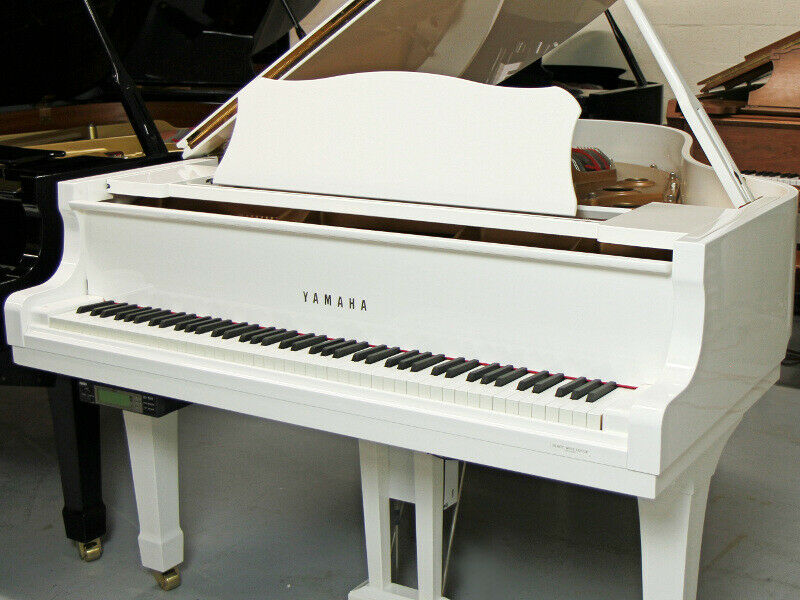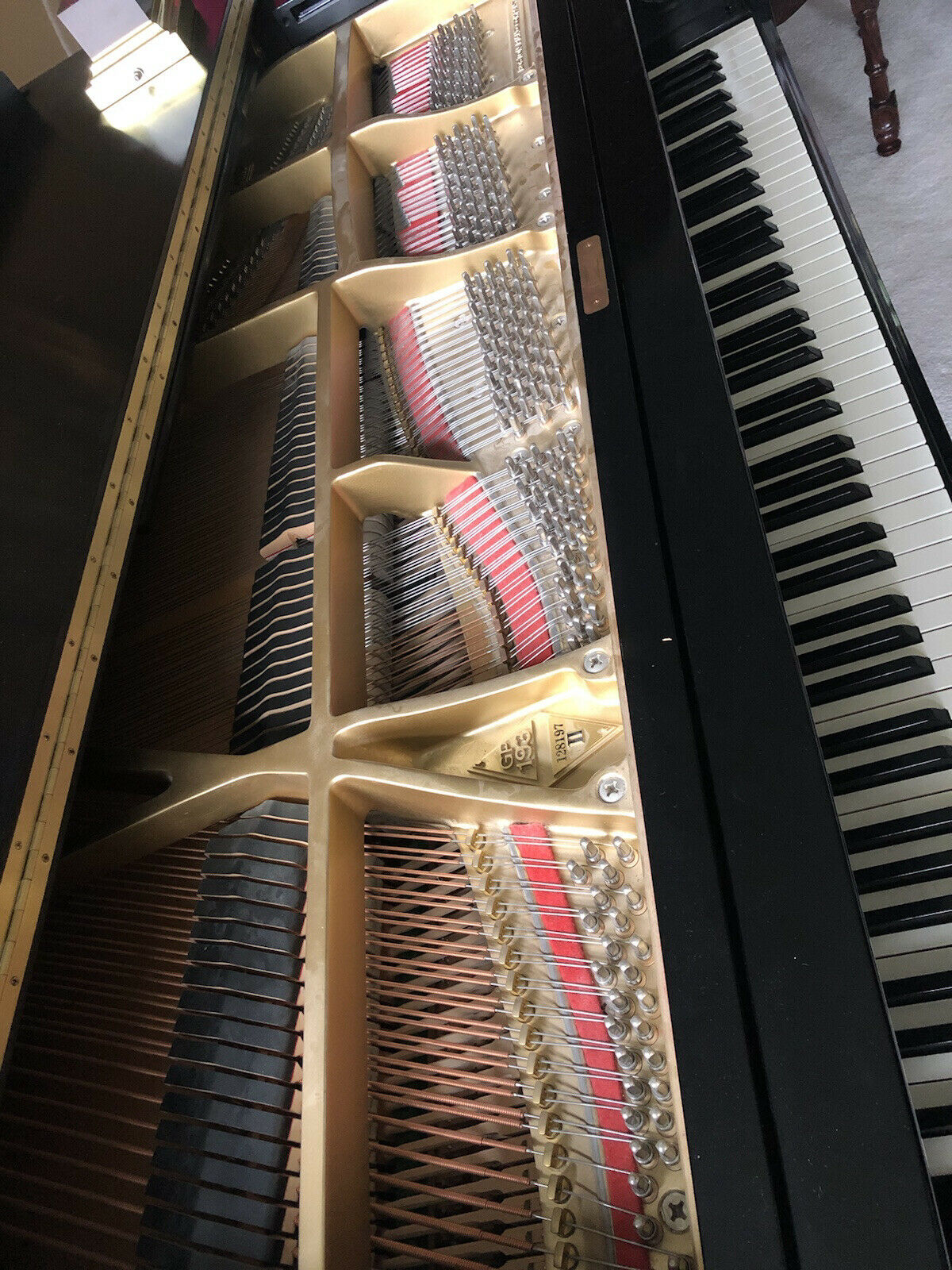-40%
Bosendorfer Boesendorfer Grand Piano 6'1" 185CS Conservatory 2015
$ 39599.47
- Description
- Size Guide
Description
Bought new from Grand Piano Haus in 2015 and had been with me since grad school. Currently live with me in Brooklyn - can be picked up in person or via professional piano movers within continental US. I'll arrange for concert-level tuning and regulation before shipping. Lovingly maintained by original owner - only light Bach pieces, very limited wear. Used exclusively in a controlled home. Serious US buyers only. Selling because of relocation.Buy with confidence - read my reviews.
Original Boesendorfer 10y warranty (parts and labor) covers until 2025. But I can help connecting with Boesendorfer for extension.
Includes:
Boesendorfer Grand Piano 6'1" 185CS Conservatory
Matching Boesendorfer bench
Original owner's set (warranty certificate, documentation, dust cover)
Complimentary tuning and regulation before shipping by concert-level technicians based in NYC
Complimentary shipping within continental US by professional piano movers based in NYC
Price guide from
https://www.pianobuyer.com/brand/bosendorfer/
185CS
6
1
Conservatory Satin Ebony
MSRP 129,999
SMP 122,998
Bösendorfer Conservatory Series.
Hand-Crafted Acoustic, the Conservatory Series
is dedicated to colleges, universities and dedicated musicians who demand the finest at a more affordable price point. These pianos feature the same unparalleled performance features with some concessions in non-critical areas such as a satin finish rather than polished. The result is a perfect piano within reach of aspiring musicians.
From a musical standpoint, the Bosendorfer Conservatory Series Pianos are identical in every way to the pianos in Bosendorfer's Artisan Collection. As the name would imply, these pianos were created to appeal to young talents, music schools, churches and conservatories where a more economical instrument is needed. Without compromising the instruments' iconic tone and touch, Bosendorfer designed these pianos with simplified cabinets and a standard ebony satin finish. Now, more people than ever can express themselves with the color and control that only a Bosendorfer piano can offer. Bosendorfer Conservatory Series Grand Pianos are also built out of Bavarian Spruce tonewood. The piano's rim and frame are still made with solid spruce. Like the Bosendorfer Artisan Collection pianos, this gives the entire piano a role in tone production - unlike other instruments whose manufactures think of the piano's frame and rim as purely structural or decorative in nature. This "Spruce Resonance Case" is made of only the finest Bavarian spruce and is naturally dried for five years before use. The piano is then fitted with a custom cast iron plate, individually-attached strings, hand-wound (bass) strings, an open pin block (for unparalleled durability and tuning stability), a custom Kluge keyboard and a custom Renner action. Riverton Piano Company is Arizona's only factory-authorized Bosendorfer dealership. Come and see us today. We look forward to introducing you to the historic Bosendorfer Conservatory Series Grand Pianos.
Bösendorfer has simplified the grandest of their hand-built grand pianos
to create instruments that satisfy the highest expectations of aspiring perfectionists. The pianos in this Bösendorfer Conservatory Series are available in sizes 214 and 200 (185 is only available in the USA.) The Conservatory Series of acoustic grand pianos will not disappoint as a showcase for technical expertise or artistic subtleties.
Pianos made by: L. Bösendorfer Klavierfabrik GmbH, Vienna, Austria
Bösendorfer was founded in 1828 in Vienna, Austria, by Ignaz Bösendorfer. The young piano maker rose to fame when Franz Liszt endorsed his concert grand after being unable to destroy it in playing, as he had every other piano set before him. Ignaz died in 1858 and the company was taken over by his son, Ludwig. Under Ludwig’s direction, the firm greatly prospered and the pianos became even more famous throughout Europe and the world. Ludwig, having no direct descendants, sold the firm to a friend, Carl Hutterstrasser, in 1909. Carl’s sons, Wolfgang and Alexander, became partners in 1931. Bösendorfer was sold to Kimball International, a U.S. manufacturer of low- and medium-priced pianos, in 1966. In 2002 Kimball, having left the piano business, sold Bösendorfer to BAWAG Bank, Austria’s third largest financial institution. The bank encountered financial troubles unrelated to Bösendorfer and sold the piano company to Yamaha in 2008. Yamaha says it will not be making any changes to Bösendorfer’s location or methods of production. Bösendorfer manufactures only around 300 pianos a year.
Bösendorfer makes a 52″ upright and eight models of grand piano, from 5′ 1″ to the 9′ 6″ Imperial Concert Grand, one of the world’s largest pianos. The company also makes slightly less expensive versions of four grand models known as the Conservatory Series (CS). Conservatory Series grands are like the regular grands except that the case receives a satin finish instead of a high polish, and some cabinet details are simpler. Previously, the CS models also had a satin-finished plate, and were loop-strung instead of single-strung, but in 2009, regarding these features, the specifications of the regular models were restored. All Bösendorfer grand pianos have three pedals, the middle pedal being a sostenuto.
One of the most distinctive features of the grands is that a couple of models have more than 88 keys. The 7′ 4″ model has 92 keys and the 9′ 6″ model has 97 keys. The lowest strings vibrate so slowly that it’s actually possible to hear the individual beats of the vibration. Piano technicians say that it is next to impossible to tune these strings by ear, although electronic tuning aids can help accomplish this. Of course, these notes are rarely used, but their presence, and the presence of the extra-long bridge and larger soundboard to accommodate them, add extra power, resonance, and clarity to the lower regular notes of the piano. In order not to confuse pianists, who rely on the normal keyboard configuration for spatial orientation while playing, the keys for these extra notes are usually covered with a black ivorine material.
The rim of the Bösendorfer grand is built quite differently from those of all other grands. Instead of veneers bent around a form, the inner rim is made in solid sections of spruce and beech that are joined together. The outer rim has a solid core of quartersawn spruce that is grooved by Bösendorfer craftsmen so that it can be bent around the inner rim; after bending, the grooved sections are filled with spruce inserts. Because spruce is better at transmitting than reflecting sound, the extensive use of spruce in the rim has the effect of making the rim an acoustical extension of the soundboard, causing the entire body of the piano to resonate. This, along with the scale design, may be why Bösendorfers tend to have a more delicate treble, and a bass that features the fundamental tone more than the higher harmonics. Although the stereotype that “Bösendorfers are better for Mozart than Rachmaninoff” may be an exaggeration (as evidenced by the number of performing artists who successfully use the piano in concert for a wide variety of music), the piano’s not-so-“in-your-face” sound is certainly ideally suited for the classical repertoire, in addition to whatever else it can do.
In recent years, Bösendorfer has made some refinements to its designs. The relatively newer 6′ 1″, 7′, and 9′ 2″ models have been designed specifically to appeal to pianists looking for a more familiar sound. These models, now called the Vienna Concert (VC) series, have redesigned scaling and soundboard for greater sound projection, improved sustain, and a wider range of tonal color and dynamics. In all models, however, the distinctive Bösendorfer sound is still readily apparent. The 9′ 2″ model 280VC has been well accepted by concert pianists, and this and other VC models can now be found in leading musical institutions and concert halls.
In past years, Bösendorfer has introduced a number of interesting instruments in new cabinet styles. These include a Porsche-designed modern piano in aluminum and polished ebony (it can be special-ordered in any standard Porsche finish color); the Liszt, Vienna, and Chopin models of Victorian-styled pianos; and limited-edition models, such as the Liszt Anniversary, Beethoven, Mozart, Hummingbird, and Schönbrunn. Perhaps not to be outdone by Porsche, in 2009 Bösendorfer produced a model commissioned and designed by Audi on the occasion of that automaker’s 100th anniversary. In 2020, Bösendorfer introduced the limited-edition Secession model, the first in a series inspired by architectural milestones of Vienna.
Various Bösendorfer models are also available with the Yamaha Disklavier ENSPIRE system installed. Perhaps the world’s most expensive piano inch for inch, Bösendorfer grands make an eloquent case for their prices. They are distinctive in both appearance and sound, and are considered to be among the finest pianos in the world. Warranty: Acoustic Piano: 10 years, parts and labor.




















